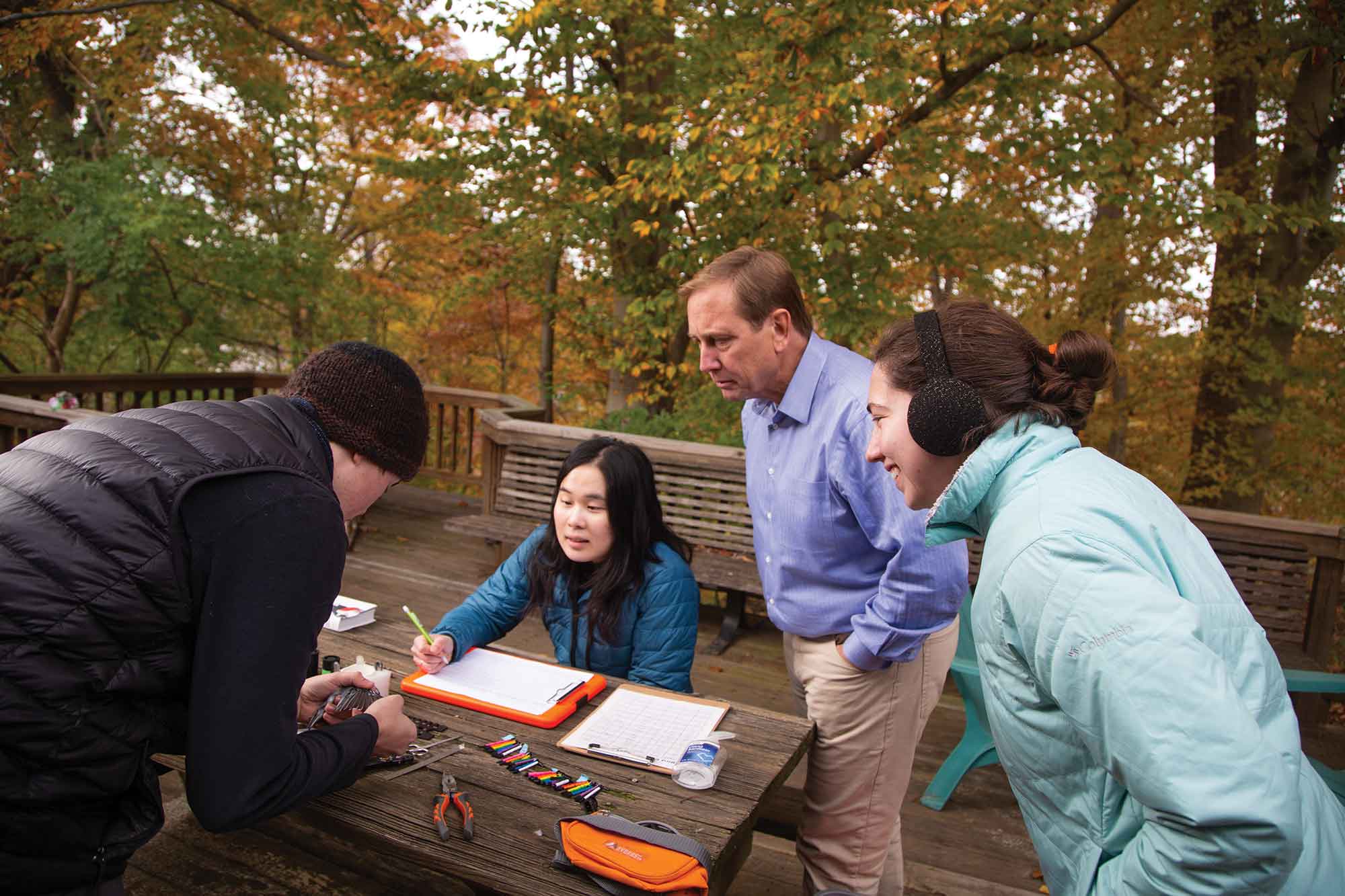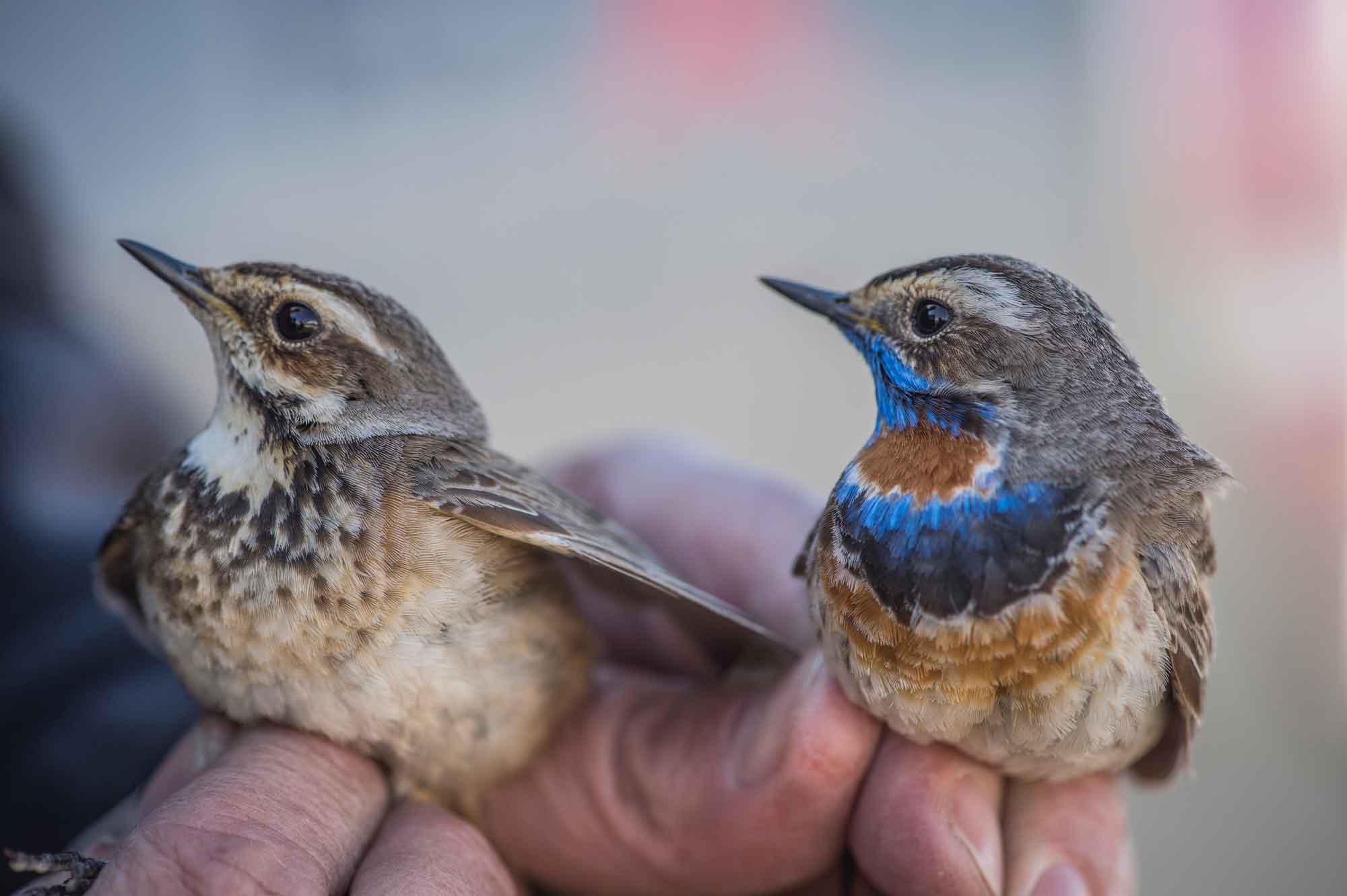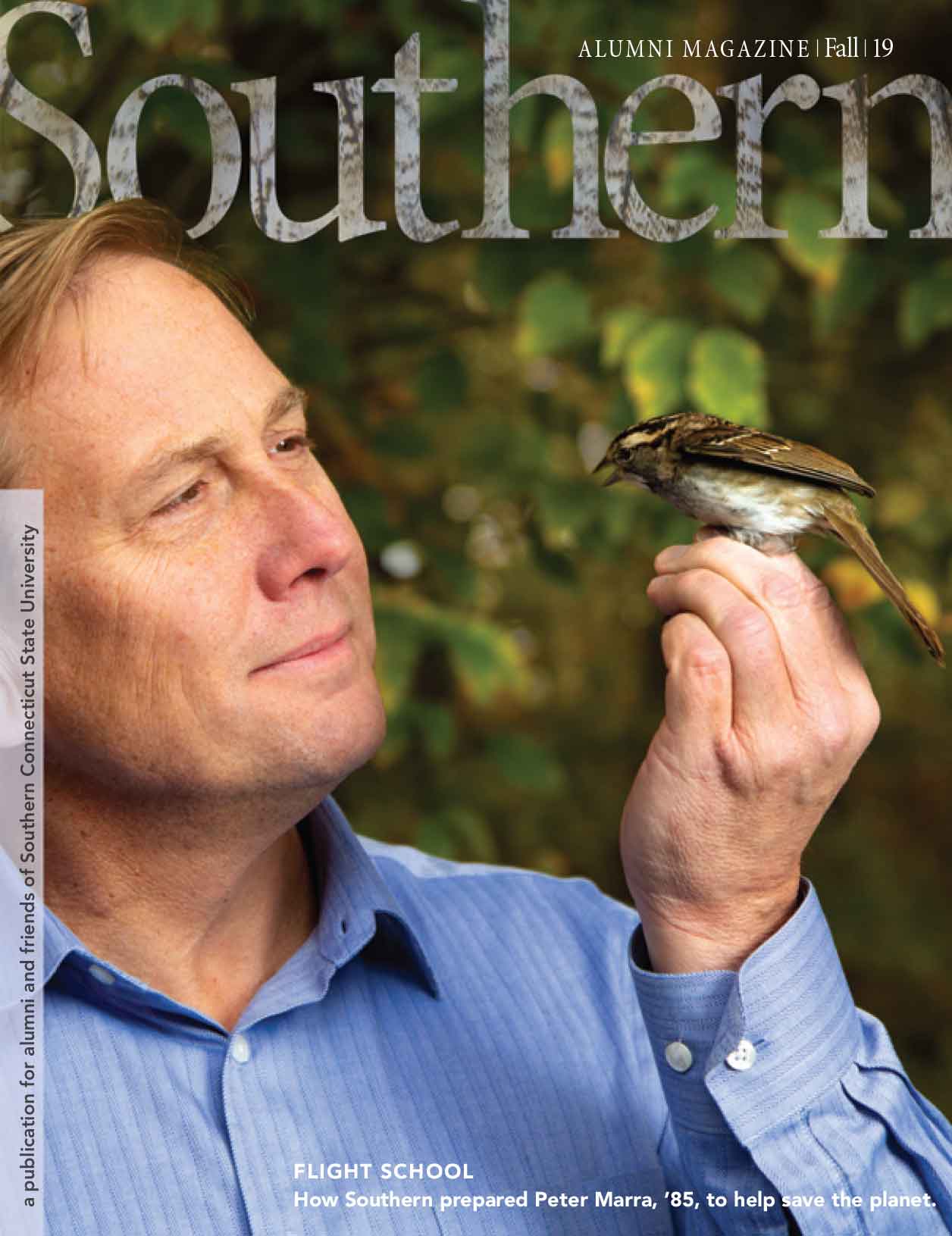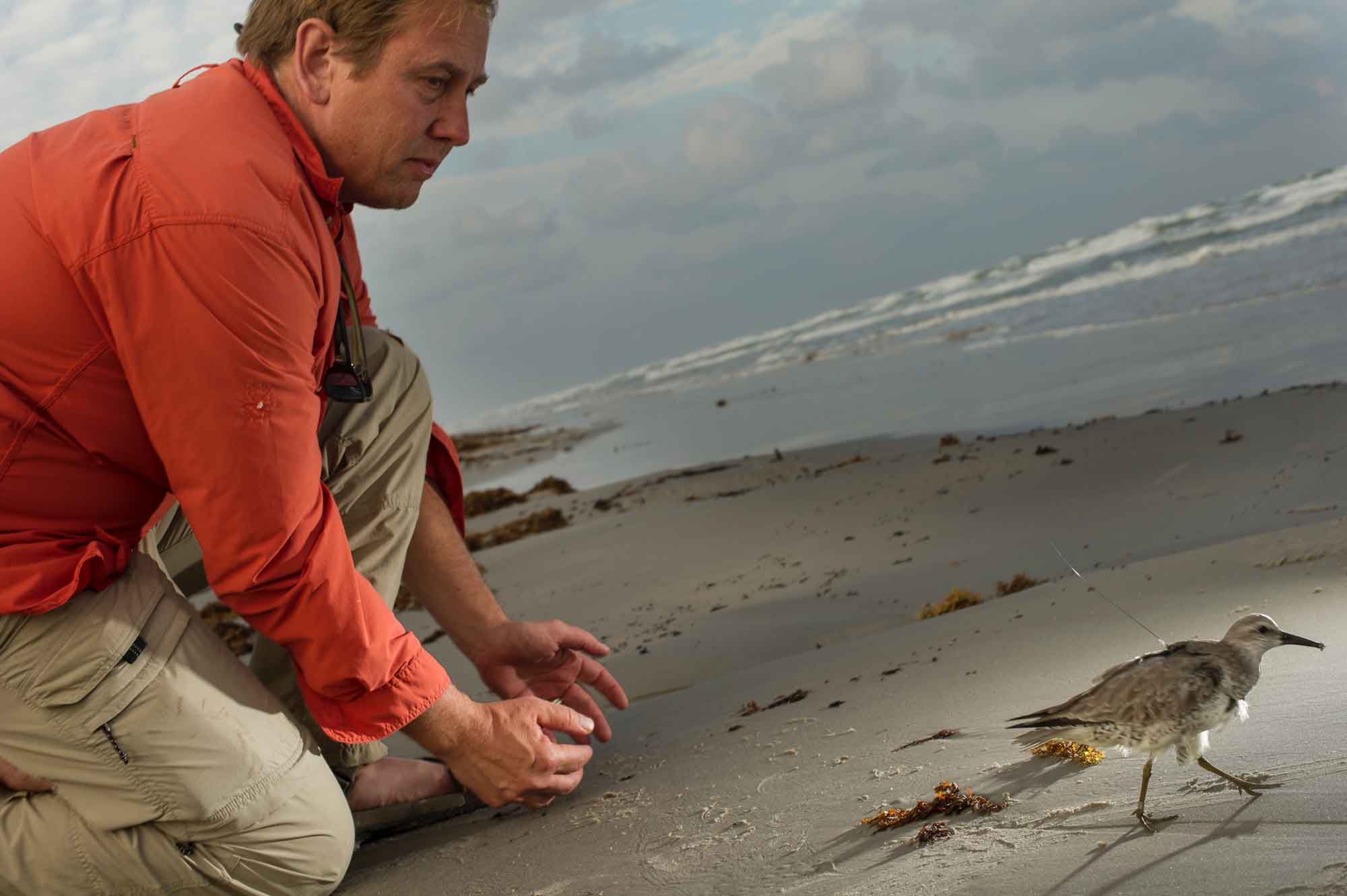Scientist Peter Marra, ’85, views the world through the eyes of a naturalist — and that includes his childhood. “I was a feral kid,” says Marra, of growing up largely unsupervised in a wooded neighborhood in Norwalk, Conn. The youngest of four siblings, he was raised in a broken home. His father, an Army veteran turned baker, left when Marra was only 1 and his mother was left seriously struggling.
By middle school, Marra was struggling as well, smoking and experimenting with alcohol. He also spent time wandering, often ending up at the neighboring Westport Nature Center. One day, the center’s staff set up a mist net: made of very fine threads, it blends with the surroundings and is used to catch birds without harming them. “I was able to experience a chickadee up close and personal. I’m pretty sure I even held it,” says Marra. “I don’t remember a lot, but I remember there being this moment that was pretty magical.”
The experience was an epiphany and a saving grace. “I could have continued down this really bad road. Some of my friends from that time did, and it didn’t end well,” says Marra, who, instead, opted to pursue his passion. Today, he’s an internationally recognized naturalist and ornithologist (expert on birds), an emeritus senior scientist with the Smithsonian Institute, and an elected fellow of the American Association for the Advancement of Science (2014).
“You could live without art. You could live without music. But would you want to? Would we want to live in a world without warblers, shorebirds, and hawks?”
— Peter Marra, ’85
In August 2019, Marra left the Smithsonian after a 20-year tenure, where he most recently served as director of the Migratory Bird Center at the National Zoo and Conservation Biology Institute in Washington, D.C. For the next chapter of his career, he’ll direct the Georgetown Environment Initiative, which integrates Georgetown University’s scholarship and outreach efforts related to the earth’s stewardship. Marra also was named the Laudato Si’ Professor of Biology and the Environment, and a professor in the McCourt School of Public Policy.
The significance isn’t lost on Marra, who notes he was first in his family “to even think about going to college.” He’d applied only to Southern for his undergraduate degree. The draw: the late Noble Proctor, ’70, M.S. ’72, professor emeritus of biology — a nationally recognized naturalist and author who, during his lifetime, traveled to some 90 countries conducting avian research. Marra, like many students, called him Nobe.
Southern proved a great match for Marra. “I think it cost me $350 a semester. Having a really quality education available to me at an affordable price made all the difference in the world,” says Marra, who studied — and often simultaneously worked — full time. As a senior, he received the university’s Award for Outstanding Achievement in Biology, and more than 30 years after graduating, he easily recalls his professors’ names. He credits Proctor with helping him secure an internship with the U.S. Department of Agriculture — he researched the interaction between gypsy moths and birds — and says the professor also helped him get into graduate school. Marra earned a master’s from Louisiana State University and a doctorate from Dartmouth College, before joining the Smithsonian in 1998.

Through it all, curiosity was a driving force. He’s jointly published more than 215 peer-reviewed papers in journals such as Science, Nature, and Proceedings of the National Academy of Sciences. His research has three broad themes: the ecology of migratory birds, urban ecosystems, and disease. Basically, if an issue relates to birds, Marra has probably investigated it. He’s studied migratory birds wintering on military bases; what happens to birds and otters when a dam is removed; and the role migratory birds play in the spread of West Nile virus.
And that’s just the tip of the iceberg for Marra, who’s received top research awards from organizations such as the Smithsonian (Secretary’s Distinguished Research Prizes in 2008 and 2010) and the American Ornithological Society (the Elliott Coues Award in 2018). In sum, Marra is an experts’ expert — the one the White House and members of Congress call for briefs on the highly contagious bird flu.
Of course, in most cases, the birds are the ones in danger, and Marra has spent his career studying direct anthropogenic stress: the many ways humans harm birds. “The number one killer is cats,” says Marra, who discusses the issue in-depth in his book, Cat Wars, the Devastating Consequences of a Cuddly Killer, co-authored with Chris Santella.
Marra estimates that cats kill 1.3 – 4 billion birds annually in the U.S. — and three to four times that many native mammals. (There’s limited data on feral cats, hence the wide-ranging statistics.) But the end results, Marra says, are devastating for bird populations. Cats have contributed to the extinction of 63 species around the world, he explains. “DDT, in comparison, has never caused the extinction of a species,” he says, stressing the importance of keeping pet cats inside and on leashes when outdoors. The book also advocates management of feral cat populations, including euthanasia in some cases.

Another decidedly less controversial research project is centered just outside of Nome, Alaska, and focuses on a small bird called the bluethroat. It’s primarily an Old World species — meaning it breeds and spends most of its life in Europe and Asia, says Marra. But long ago, one population of bluethroats started traveling to Alaska. The birds annually arrive in May and remain through June to breed. These bluethroats then migrate to another location. “Probably to someplace in Southeast Asia, but we don’t know where,” says Marra.
In summer 2018, Marra and other researchers began catching the birds and tagging their backs with light-level geolocators that use daylight to estimate location. It’s an intense process. In Alaska, Marra jump-started the day with a cup of coffee, followed by trudging through deep snowbanks to reach small patches of vegetation. The goal: stay clear of musk ox and grizzlies while searching for the newly arrived bluethroats, which must be caught and tagged.
The scientists then wait. “If we catch the birds again when they come back next year, we can download the data off their backs,” says Marra. The project was a dream assignment for the naturalist, who is working on The Atlas of Migratory Connectivity for the Birds of North America. Still, recapturing a bird is a challenging task. Only about one in every five birds that scientists tag is captured again the next year, according to the Smithsonian. But Marra remains undaunted, inspired by how much remains to be learned.
“The last 10 years, we’ve made some real advances because of the miniaturization of tracking devices and other technology. It’s been a remarkable time to be in migratory animal ecology,” he says.
Marra’s new post as head of the Georgetown Environment Initiative will capitalize on his commitment. Ask Marra why we should care about the conservation of various bird species, and he turns thoughtful. There are practicalities: removing insects and rodents, spreading seeds, pollinating plants. Birds fulfill critical ecosystem services, he explains: when populations decline or worse, become extinct, it’s a sign that something is deeply unhealthy with the environment.
Other motivations are more difficult to articulate, says the conservationist. “You could live without art. You could live without music. But would you want to?” asks Marra. “Would we want to live in a world without warblers, shorebirds, and hawks? I don’t think so. . . .When I wake up in the morning and hear birdsong outside — that fulfills me.” ♦
Bird Calls
Want to attract more birds to your yard? Get planting — and be sure to include as many native species as possible, according to a study from the Smithsonian Conservation Biology Institute. The magic ratio of native plants? Seventy percent.
“If more than 30 percent of the [plant] species in your yard are non-native, your yard will not produce enough insects to successfully support bird populations,” says Peter Marra, ’85, outlining the results of a study published in the Proceedings of the National Academy of Sciences of the United States of America.
The research looked specifically at chickadees, but has widespread implications. More than 90 percent of herbivorous insects target only one or a select few plants for food. “Everybody, even those in an urban or suburban environment, should be thinking about their yard as a natural park, a place that wildlife depends on — including insects and birds,” says Marra.
The Smithsonian suggests these online sites for information on bird-friendly plants: the Audubon’s Native Plants Database, the National Wildlife Federation’s Native Plant Finder, and the United States Department of Agriculture’s Plant Hardiness map. The study was funded by the National Science Foundation and conducted in conjunction with the University of Delaware.



